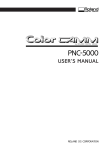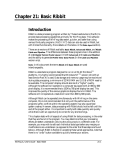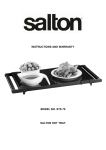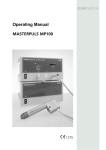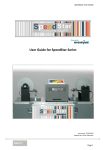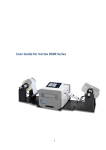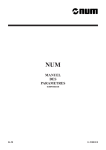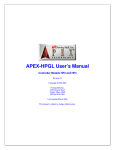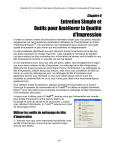Download Roland PC-50 User`s manual
Transcript
PC-50 USER'S MANUAL For the USA FEDERAL COMMUNICATIONS COMMISSION RADIO FREQUENCY INTERFERENCE STATEMENT This equipment has been tested and found to comply with the limits for a Class A digital device, pursuant to Part 15 of the FCC Rules. These limits are designed to provide reasonable protection against harmful interference when the equipment is operated in a commercial environment. This equipment generates, uses, and can radiate radio frequency energy and, if not installed and used in accordance with the instruction manual, may cause harmful interference to radio communications. Operation of this equipment in a residential area is likely to cause harmful interference in which case the user will be required to correct the interference at his own expense. NOTICE Grounding Instructions Do not modify the plug provided - if it will not fit the outlet, have the proper outlet installed by a qualified electrician. Check with qualified electrician or service personnel if the grounding instructions are not completely understood, or if in doubt as to whether the tool is properly grounded. Use only 3-wire extension cords that have 3-prong grounding plugs and 3-pole receptacles that accept the tool’s plug. Repair or replace damaged or worn out cord immediately. Operating Instructions KEEP WORK AREA CLEAN. Cluttered areas and benches invites accidents. Unauthorized changes or modification to this system can void the users authority to operate this equipment. DON’T USE IN DANGEROUS ENVIRONMENT. Don’t use power tools in damp or wet locations, or expose them to rain. Keep work area well lighted. DISCONNECT TOOLS before servicing; when changing accessories, such as blades, bits, cutters, and like. The I/O cables between this equipment and the computing device must be shielded. REDUCE THE RISK OF UNINTENTIONAL STARTING. Make sure the switch is in off position before plugging in. USE RECOMMENDED ACCESSORIES. Consult the owner’s manual for recommended accessories. The use of improper accessories may cause risk of injury to persons. NEVER LEAVE TOOL RUNNING UNATTENDED. TURN POWER OFF. Don’t leave tool until it comes to a complete stop. For Canada CLASS A NOTICE This Class A digital apparatus meets all requirements of the Canadian Interference-Causing Equipment Regulations. CLASSE A AVIS Cet appareil numérique de la classe A respecte toutes les exigences du Règlement sur le matériel brouilleur du Canada. ROLAND DG CORPORATION 1227 Ohkubo-cho, Hamamatsu-shi, Shizuoka-ken, JAPAN 432 MODEL NAME : See the MODEL given on the rating plate. RELEVANT DIRECTIVE : EC MACHINERY DIRECTIVE (89/392/EEC) EC LOW VOLTAGE DIRECTIVE (73/23/EEC) EC ELECTROMAGNETIC COMPATIBILITY DIRECTIVE (89/336/EEC) WARNING This is a Class A product. In a domestic environment this product may cause radio interference in which case the user may be required to take adequate measures. Table of Contents Thank you very much for purchasing the <Color CAMM> Model PC-50. • To ensure correct and safe usage with a full understanding of this product's performance, please be sure to read through this manual completely and store it in a safe location. • Unauthorized copying or transferal, in whole or in part, of this manual is prohibited. • The contents of this operation manual and the specifications of this product are subject to change without notice. • The operation manual and the product have been prepared and tested as much as possible. If you find any misprint or error, please inform us. Table of Contents Typographic Conventions ..........................................................................................................................2 To Ensure Safe Use ................................................................................................................2 About the Labels Affixed to the Unit ...............................................................2 To Ensure Correct Use .............................................................................................................................2 1 Checking Supplied Items ......................................................................................................................3 2 Part Names and Functions ...................................................................................................................3 2-1 Front View .......................................................................................................................................3 2-2 Rear View ........................................................................................................................................3 2-3 Operation Panel .............................................................................................................................4 3 Set-up and Connections .......................................................................................................................5 4 What the PC-50 Can Do .........................................................................................................................5 5 Basic Operation .......................................................................................................................................6 5-1 DIP Switch Settings .......................................................................................................................6 5-2 Powering On ...................................................................................................................................6 5-3 Installing/Removing a Blade .........................................................................................................7 5-4 Installing a Ribbon Cartridge ........................................................................................................ 8 5-5 Loading/Removing the Material ................................................................................................ 10 5-6 Downloading Printing/Cutting Data ...........................................................................................11 5-7 Pausing Operations ..................................................................................................................... 11 5-8 Moving the Base Point for Printing or Cutting ........................................................................ 12 5-9 Cutting Test to Check Cutter Force .......................................................................................... 12 5-10 Performing a Self-test ................................................................................................................ 13 5-11 Powering Off ................................................................................................................................ 13 6 To Perform Long Printing/Cutting ................................................................................................... 14 7 Printing and Cutting Samples .......................................................................................................... 15 8 About the Printing/Cutting Area ....................................................................................................... 16 9 About the Blade .................................................................................................................................... 17 10 Care and Maintenance ........................................................................................................................ 18 11 What to Do If... ...................................................................................................................................... 19 12 Specifications of PC-50 ...................................................................................................................... 22 Clipart used this manual is from CorelDRAWTM Windows is a registered trademark or trademark of Microsoft Corporation in the United States and/or other countries. Copyright © 1996 ROLAND DG CORPORATION 1 Typographic Conventions / To Ensure Safe Use Typographic Conventions This manual uses typographic conventions which are outlined at the right. This indicates a point requiring particular care to ensure safe use of the product. : Failure to heed this message will result in serious injury or death. : Failure to heed this message may result in serious injury or death. : Failure to heed this message may result in minor injury. NOTICE : Indicates important information to prevent machine breakdown or malfunction and ensure correct use. : Indicates a handy tip or advice regarding use. To Ensure Safe Use Never disassemble or modify this product. Do not allow liquids, metal objects or flammables inside the machine. Fire or breakdown may result. Handle the power cord with care. Do not step on or damage the power cord, or allow heavy objects to be placed atop it. Failure to heed may result in electrocution or fire. Do not install in an unstable or high location. Ensure the safety of the area around the platen before switching on the power. The carriage moves simultaneously when the power is switched on. ON Handle the blade with care. Do not install the machine on the edge of a table, or it may fall. Do not inadvertently allow the hands, hair, or necktie near the carriage while in operation. About the Labels Affixed to the Unit These labels are affixed to the body of this product. The following figure describes the location. Do not allow the hands near the platen while in operation. To Ensure Correct Use NOTICE This product is a precision instrument and must be handled with care. NOTICE Do not install in an area subject to dust, high humidity or poor ventilation. NOTICE NOTICE Do not connect to an AC outlet that supplies other than the specified voltage. 100 V 117 V 220 V When the unit is not in use for an extended period, detach the electrical plug from the AC outlet. 3 2 240 V 2 When pulling the power cord from an electrical socket, be sure to grip the plug. 240 V 1 Do not place hands near the platen while in operation. 1 Checking Supplied Items / 2 Part Names and Functions 1 Checking Supplied Items Check the following to make sure that you received all the items that were shipped along with the unit. Power Cord Thermal transfer ribbon cartridge Cleaning Sheet for Printing Head Roller Base PC-50 DRIVER for windows 95 PC-50 DRIVER for windows 3.1 Blade (Carbide) Blade Holder Material for Test Cuts Cutter Tool Head Cleaner User's Manual 2 Part Names and Functions 2-1 Front View Cutting Carriage Printing Carriage The blade holder is mounted here. The ribbon cartridge is mounted here. Pinch Roller (Right) This presses the material against the grit roller. Pinch Roller (Left) Press material against the grit roller. When loading material, place the left roller inside the left edge of the material to correctly track it through the machine. Cutter Force Control Slider Sets the down force for the cutting tool. DIP Switches Used to make various settings. Cleaning pad * Please do not remove this pad. Removing it may result in breakdown. Serial (RS-232C) Input Connector Material Alignment Sticker In a serial configuration, connect the serial cable here. This cable carries data to your computer. Grit Roller Parallel (Centronics) Input Connector Platen In a parallel configuration, connect the parallel cable here. This cable carries data to your computer. Guide Line Align the material with these lines when loading. Operation Panel 3 2 Part Names and Functions 2-2 Rear View Sheet Loading Lever Used to raise or lower the pinch rollers when loading or unloading material. Power Switch Guide Line Align the material with these lines when loading. Power Connector (AC IN) This connector accepts standard AC power cord. 2-3 Operation Panel SETUP Key SETUP LED Lights when the SETUP key is pressed. Operations can be performed when lighted. PAUSE LED Lights when the PAUSE key is pressed to stop the PC-50 temporarily. BASE POINT SET LED Lights when the base point is set. CHANGE LED Flashes when the ribbon cartridge is being changed. Pressing this key after loading material detects the position of the pinch rollers and automatically determines the area for printing or cutting. Also, pressing this key after using the PAUSE key to temporarily stop an operation in progress will delete the data that has been sent to the PC50 from the computer. This key must be pressed in order to begin printing or cutting. PAUSE Key When pressed once, this key temporarily halts operation in progress. Pressing this key again releases the paused state. BASE POINT SET Key Sets the current position of the blade to the base point for printing or cutting. BUSY LED Flashes (orange) when while receiving data from the computer, and lights (green) during operation. This goes dark when operation ends. CLEANING Key Cleans the printing head. For more details, see "10 Care and Maintenance." TEST Key Executes a cutting test to check material characteristics, cut quality, and suitable pressure for the blade. POWER/ERROR LED Lights when the power is switched on and flashes when an error is generated. 4 CHANGE Key Press this key after replacing the ribbon cartridge. The PC-50 checks to make sure the ribbon cartridge has been changed, and printing resumes. (Cursor Keys) Pressing the , , , and keys causes the tool or material to move in the specified direction. 3 Set-up and Connections / 4 What the PC-50 Can Do The SETUP LED and POWER/ERROR LED blink simultaneously. The SETUP LED and POWER/ERROR LED blink simultaneously if material is not loaded correctly. See “5-5 Loading/Removing Material” for an explanation of how to load material. The PAUSE LED and CHANGE LED blink simultaneously. The PAUSE LED and CHANGE LED blink simultaneously if no ribbon cartridge is installed, or if the ink ribbon has run out. For more details, see “5-4 Installing a Ribbon Cartridge.” 3 Set-up and Connections When arranging setup space for the PC-50, make sure you have a space that is at least 950 mm (37-7/16") wide, 500 mm (19-11/16") in depth, and 230 mm (9-1/16") in height. Since the material moves during printing and cutting, make sure the unit is placed on a stable, sturdy surface. Also make sure there is nothing that can block the material at both front and rear. NOTICE • Avoid installing the PC-50 in the following conditions, as this may result in damage to the machine. Avoid places subject to strong electrical noise. Avoid excessively dusty or damp places. Never leave the unit in a place that is subject to direct sunlight or extreme temperatures. Because it is normal for this device to emit heat when in operation, never place it in an area with poor ventilation. • Do not try to pick up or move the PC-50 by grasping the top area of the unit. Be sure to use both hands to grip the PC-50 securely on the left and right sides. • Always make sure that the power is off on both the computer and the PC-50 whenever any cables are connected or disconnected. • Ensure that the power supply voltage in within ±10% of the machine's rated voltage. Cables are available separately. One which you are sure matches the model of computer being used should be selected. Power outlet Power connector Power cord Serial interface cable Serial connector or parallel connector Parallel input connector Serial input connector Parallel interface cable 4 Here’s What the PC-50 Can Do • Print color graphics on vinyl film and other materials. • Custom cut vinyl film and other materials. • Print color graphics on vinyl film and other materials, and then immediately custom cut the material. 5 5 Basic Operation 5 Basic Operation 5-1 DIP Switch Settings DIP switch Function OFF ON SW-1 Baud rate 9600 19200 SW-2 Parity Disable Enable SW-3 Parity ODD EVEN SW-4 Handshake Hardwire XON/XOFF SW-5 Front edge sense Disable Enable SW-6 Cut sheet mode Disable Enable SW-7 Blade offset 0.25 0.5* SW-8 Long output mode Light Heavy SW-9 Prefeed mode Enable Disable SW-10 (Not Used) – – NOTICE DIP switches settings must be made only when the power is turned off. *This option should be selected only when you are using optional blade, ZEC-U3050. Please contact your dealer for more information. All DIP switches are set to OFF when shipped from the factory. The DIP switches are located on the right face of the unit, near the bottom. SW-1–4 : Sets the communication parameters for a serial connection. When the PC-50 is connected to the computer through the serial port, be sure that the communication parameters for SW-1 to SW-4 are set correctly, matching the computer port settings. (Data length is fixed to 8 bits. It is automatically determined whether the number of stop bits is 1 or 2.) SW-5 : Detects automatically the front edge of loaded material. To detect the front edge of loaded material, set SW-5 to ON (enabled). SW-6 : Detects length of cut material automatically. Switch to ON (enabled) when loading sheet material, and OFF (disabled) when loading roll material. SW-7 : Sets the amount of offset for the cutter blade. Set to OFF when using a tool with a blade offset of 0.25 mm, or to ON when using a tool with a blade offset of 0.5 mm. SW-8 : Sets the weight of the material. SW-8, which controls the material weight, should normally be set to OFF (light). Cutting speed slows down when switch is turned ON, but the force used to move the material and the blade increases. SW-9 : Acclimates the machine and the material before cutting or printing, which can produce more attractive printing or cutting results. This is normally set to OFF (enabled). (When the cut-sheet mode (SW-6) is set to ON (enabled), the prefeed mode is disabled, regardless of the setting of SW-9.) 5-2 Powering On Press the side of the switch marked “ | ”. 6 When the power switch is pressed to power on the unit, the tool carriage moves. Use caution to ensure that your hands or other objects do not become caught in the moving parts. 5 Basic Operation 5-3 Installing/Removing a Blade NOTICE Do not touch the tip of the blade. This could impair the cutting performance of the blade. Installation 1 Insert blade into the blade holder until it snaps into place with an audible click. 2 2) Support the tool-securing screw from below and install the blade holder. * Insert the blade holder until the collar is flush with the carriage. Push-pin Cutting carriage Blade holder 1) Loosen 3) Tighten Blade Tool-securing screw Adjusting the Cutter Blade When stock vinyl film is to be cut, tighten the cap all the way (2.5 mm (about 0.1") of blade extension). Tighten the cap until gap is eliminated Amount of cutter blade extension: 2.5 mm (about 0.1") (maximum length) Turn the cap as shown by the arrow Blade adjustment may be necessary when: - cutting material whose carrier paper is thinner than the material itself - cutting material with no carrier paper 1) 2) Gap Thickness of the sheet portion Amount of cutter blade extension: 0 mm Amount of cutter blade extension Turn the cap as shown by the arrow Turn the cap as shown by the arrow to align the tip of the blade with the tip of the cap Thickness of the carrier paper NOTICE When cutting is performed after printing, the cap tip of the blade holder may scratch the printed surface. If this is the case, lengthen the cutter blade extension. Removal 1 2) Remove the blade holder from the cutting carriage. Cutting carriage 1) Loosen Tool-securing screw Leave the tool-securing screw loose. Tightening the screw makes it more difficult to install the blade holder. 2 Push-pin Blade holder Press the push-pin and remove the blade from the blade holder. Blade If a blade was used, wipe the blade with a soft cloth to remove any material that may cling to it. 7 5 Basic Operation 5-4 Installing a Ribbon Cartridge NOTICE • A used ribbon cartridge cannot be reused. Do not attempt to turn over and reinstall a used ribbon cartridge, or to rewind the ink ribbon and reuse the cartridge. • If a single-color ink ribbon has been used for printing, do not attempt to print overtop of this with a four-color ink ribbon or an ink ribbon of a different color. • Before starting to print, make sure that a ribbon cartridge of the desired color has been installed. • If only cutting is to be performed, there is no need to install a ribbon cartridge. Remove Excess Slack from the Ink Ribbon 2) Install the ribbon cartridge. Printing head 1) Open the cover. 3) Close the cover. Take care to ensure that the ink ribbon is not pinched when the cover is closed. The ink ribbon may show some slack when the stopper has been removed from the ribbon cartridge. If this is the case, the slack should be taken up before the ribbon cartridge is installed. Ink ribbon Use your finger or a pen to take up excess slack in the ink ribbon. Take care to ensure that the ink ribbon does not catch on the printing head. Remove the stopper If the ink ribbon runs out while printing 1) If the ink ribbon runs out during printing, operation stops. The PAUSE LED and CHANGE LED will blink simultaneously. 2) Remove the old ribbon cartridge. 3) Install a new ribbon cartridge, then press the CHANGE key. (Be sure to install an ink ribbon of the same type as the old one.) How to Perform Printing Process Color Printing Full-color printing is performed using the process colors CYAN (C), MAGENTA (M), YELLOW (Y), and BLACK (K). The method used for printing depends on the type of cartridges that are installed. When using a CR-4C ribbon cartridge All four CMYK colors are contained in a single ribbon cartridge, so there is no need to change cartridges during printing. The cartridge contains successive lengths of ribbon of each color. If data is sent to the machine while a single-color ribbon cartridge is installed, the carriage specifies "SPECIAL COLOR" and stops. When this happens, replace the cartridge to CR-4C and press the CHANGE key. When using CR-CY, MG, YE, and BK ribbon cartridges During printing, the single-color ribbon cartridges are manually changed according to the color required. This method is more economical than using the CR-4C, because no portions for ink ribbons are wasted. CR-CY, MG, YE, and BK ribbon cartridges are sold separately. 8 5 Basic Operation When CR-CY, MG, YE, and BK ribbon cartridges are used for printing, the PC-50 performs printing in the following color sequence: MAGENTA (M) CYAN (C) BLACK (K) YELLOW (Y) Follow the steps below to install and change the ribbon cartridges. 1 When data is sent, the carriage first specifies MAGENTA and stops. The CHANGE LED blink 2 3 First install the MAGENTA (CR-MG) ribbon cartridge. MAGENTA (CR-MG) Press the CHANGE key. When the MAGENTA printing is finished, the carriage indicates the next color (CYAN) and stops. The CHANGE LED blink 4 5 Replace the MAGENTA (CRMG) cartridge with the CYAN (CR-CY) cartridge, then press the CHANGE key. CYAN (CR-CY) When the CYAN printing is finished, the carriage indicates the next color (BLACK) and stops. The CHANGE LED blink 6 Use the same procedure to change to the BLACK (CR-BK) and YELLOW (CR-YE) ribbon cartridges. * If any of the four colors (C, M, Y, or K) is not used, the PC-50 does not stop at that color. Special color Printing This is used to add emphasis to some areas, or when printing with limited colors. Special-color ribbon cartridges are sold separately. When the ribbon cartridge needs to be changed, the carriage stops at SPECIAL COLOR. For more details, please refer to the operator's manual for the software driver, or to online help. 9 5 Basic Operation 5-5 Loading/Removing the Material Loading the Material Material with a width (horizontal dimension) of 279.4 mm (11") to 482.6 mm (19") can be loaded. Any length (vertical dimension) of 110 mm (4-3/8") or more is acceptable. • The tool carriage moves when the SETUP key is pressed. Take care to ensure that your hands or other objects do not get caught in the moving parts. • A soiled material may impair printing accuracy. If dirt or oils from the hand are transferred to the material when it is loaded, use a cloth moistened with alcohol to wipe the material clean before printing. NOTICE Never move the tool carriage by hand. Damage and poor performance may result. 1 1) Raise the sheet loading lever. 2) Move the right-hand pinch roller until it makes contact. 3) Pass the material between the pinch rollers and the grit roller. Guide lines 5) Move the pinch roller to the left-hand edge of the material. Inner side of the material 4) Right side of the material to be placed at front and rear guide lines. * Before attempting to move the pinch roller, be sure to raise the sheet loading lever. When using roll material 1) Load roll material on the sheet base included with the PC-50. Roll material 3) Pass the end of the material between the pinch rollers and the grid rollers so that it extends from the front of the unit. Front Pull out the amount of roll material to be used. Roller base Rear 2) Gently press the roll material against the rear surface of the unit as shown in the figure. 2 Lower the sheet loading levers to secure the material in place. 3 Press the SETUP key. Sheet loading lever The SETUP LED lights up 10 5 Basic Operation Removal 1 2 Press the SETUP key. Raise the sheet loading lever. The SETUP LED goes out The carriages moves to the left edge of the printing/cutting area. Use the separate blade included with the PC-50 to cut the material off of the roll. 5-6 Downloading Printing/Cutting Data The unit will begin printing/cutting when it receives printing/cutting data sent from the computer. For further details, refer to the user's manual provided with your software. 5-7 Pausing Operations If you want to stop the PC-50 momentarily while it is printing or cutting, follow the procedure described below. 1 Press the PAUSE key. The PAUSE LED lights up Printing or cutting is paused. 2 To resume printing or cutting To Terminate printing or cutting Press the PAUSE key. 1) Halt transmission of printing or cutting instructions from the computer. 2) Press the SETUP key. The PAUSE LED goes out Printing or cutting is resumes. The SETUP LED goes out Printing or cutting instructions already sent from the computer to the PC-50 are deleted, and operation stops. 11 5 Basic Operation 5-8 Moving the Base Point for Printing or Cutting The BASE POINT SET key can be used to move the base point for printing or cutting. Use all areas of the material effectively, without waste. 1 The carriage moves to the new base point. 2 < Example > Press the BASE POINT SET key. NEW BASE POINT The BASE POINT SET LED lights up *If the base point has been moved, the sheet-width value for the Windows driver should be entered again. If this value is not corrected, output results may be cut off before reaching their normal end. Rear Front H W Enter this value NEW BASE POINT 5-9 Cutting Test to Check Cutter Force Before cutting, you may wish to perform a “cutting test” to learn whether the unit cut satisfactorily. If cutting is to be continued on the same material, there is no need to perform a cutting test. Move the cutter force control slider all the way to the left (minimum cutter force). 1 Use the , , , and keys to move the tool carriage to the position on the material where the cutting test is to be executed. * Note that an area of approximately 2 square centimeters (a little less than a square inch) is required to make a test cut. 3 1) First peel off the round section (shaded as shown ). When it can be peeled by itself, without disturbing the square, the cutter force is set appropriately. 2) Next, peel off the square, and look at the backing behind it. The optimum blade pressure is correct if you can clearly make out the lines left by the blade. Adjust the cutter force control slider until results as shown above are obtained. (Gradually increase the cutter force until you reach the optimum level.) 12 2 Press the TEST key. Cutting test starts. Peel off first Then peel this off Origin (when using roll material) 5 Basic Operation 5-10 Performing a Self-test The PC-50 is equipped with a “self-test” function to allow you to check whether or not it is capable of operating normally. If the PC-50 is not performing correctly, follow the steps below to perform a self-test. A computer is not required in order to carry out the self-test. 1 3 Install a blade and ribbon cartridge in the PC-50. Performing a cutting test. Load the material, and press the SETUP key. Operations is normal if the figure shown at below. 2 Hold down the key on the panel while you turn the power on. + 5-11 Powering Off NOTICE • Do not switch off the power while the printing head is lowered. Doing so may damage the head and impair printing performance. Ribbon cartridge Printing head is lowered Platen • When the unit is not in use, keep the pinch rollers raised. The pinch rollers may be deformed if left engaged. • If you do not intend to use the unit for an extended period of time, disconnect the unit from the power outlet. Press the side of the switch marked with “ ”. When the SETUP key is pressed to release the setup state, the carriage moves to the position shown in the figure, then stops. Switch off the power when the carriage is at this position. Carriage position when switching off the power 13 6 To Perform Long Printing/Cutting 6 To Perform Long Printing/Cutting When performing printing or cutting over a length of 1.5 m (60") or more, first feed out the required length of material. Then follow the steps below to load the material. 4 1 Pull out the material from the roll and pass it through the unit. Pull out the amount of roll material to be used. Use material that is wider by 50 mm (2") or more than the width of the printing or cutting to be performed. 3 Guide line 25 mm (1") or more 2 Material alignment stickers 25 mm (1") or more Guide line 5 Press the SETUP key. 6 Feed out the length of material to be printed or cut. Make sure that the material remains held by the pinch rollers. If the material does come loose from the pinch rollers, set it in place again. 14 7 8 Material alignment stickers Return the fed-out material. After finishing the setup for the material, send the data from the computer. 7 Printing and Cutting Samples 7 Printing and Cutting Samples Removing the blank space surrounding a picture Cutting outline Material Stick Adding color to a border Cutting outline Stick Material Correcting Line Pitch Line pitch: Correct Line pitch is too narrow, and ink overlaps. Line pitch is too wide, and spaces appear between lines. Line-pitch correction: Set to “Wide” or “Extra Wide” Line-pitch correction: Set to “Narrow” or “Extra Narrow” How to Correct Line Pitch Hold down the SETUP key and switch on the power. Pressing the or key changes the pattern in which the PAUSE LED, BASE POINT SET LED, and CHANGE LED light up. This pattern indicates the current line pitch. Use the table at right as a reference to press the and keys and make the desired line-pitch setting. After making the setting, press the SETUP key (the SETUP LED will light up). (If material is not loaded, be sure to load one before pressing the SETUP key.) The setting that has been made is stored in memory even after the power is switched off. To change the setting, simply repeat the procedure just described. * Distance accuracy cannot be guaranteed when line-pitch correction has been performed. Line-pitch Extra wide correction LED display pattern Wide Default (no correction) Narrow Extra narrow Lighted Blinking Dark Dark Dark Dark Blinking Lighted Blinking Dark Dark Dark Dark Blinking Lighted 15 7 Printing and Cutting Samples / 8 About the Printing/Cutting Area / 9 About the Blade Printing with a width of 210 mm or more (using a 4-color ribbon cartridge) 210 mm (8-1/4") (length of the ink ribbon) OK No good Ink-ribbon seam Take steps to ensure that the printing data does not overlap with the ink-ribbon seam 8 About the Printing/Cutting Area Factory default When DIP switch SW-5 (front edge sense) is ON (enabled) Pinch roller (left) Pinch roller (left) Pinch roller (left) 12.5 mm (1/2") 6.5 mm (5/16") 25 mm (1") or more When DIP switch SW-6 (cut sheet mode) is ON (enabled) 50 mm (2") 12.5 mm (1/2") 6.5 mm (5/16") 110 mm (4-3/8") or more 25 mm (1") 12.5 mm (1/2") ..... Printing/Cutting area 6.5 mm (5/16") 25 mm (1") 9 About the Blade If the blade becomes dull When the blade starts to lose its sharpness, try gradually increasing the cutter force. Increasing the cutter force temporarily allows the blade to perform better. However, once the blade is dull, it is time to replace it. Average blade life The life of a blade varies, depending on the amount of cutting it performs. The total cutting length can vary considerably, depending on the thickness, toughness, and type of adhesive of the cut material. Set an appropriate cutter force, one that is well matched to the material and the hardness of the blade. This will extend the life of the blade. Excessive cutter forces can cause the blade to wear out quickly. Care should be taken. 16 10 Care and Maintenance 10 Care and Maintenance Cleaning the printing head Before performing printing, clean the printing head. In order to maintain attractive image quality, we recommend performing cleaning each time printing has been carried out. Ordinary soiling can be removed using the method described here. If soiling is severe, remove it by performing cleaning with a cleaning sheet. 1 2 TAKE OUT the ink-ribbon cartridge REMOVE the blade holder Pressing the CLEANING key has no effect if an ink cartridge is installed. Remove the ink cartridge before pressing the key. 3 Press the CLEANING key Head cleaning is finished when the carriage stops moving. The Cleaning Pad If the cleaning pad on the left edge of the unit's front surface is damaged, the printing head may be destroyed. If the cleaning pad is damaged by a blade or the like, please contact your authorized Roland DG Corp. dealer or service center. (This pad replacement is a charged service.) 17 10 Care and Maintenance Cleaning with cleaning sheet Soiling which cannot be removed by ordinary cleaning is removed using a cleaning sheet. NOTICE • Do not use any cleaning sheet that has a damaged surface such as cuts, tears or creases. • The printing head can be damaged by dust. • The Pinch rollers should be set over the black bands at either end of the sheet, to ensure that the head is restricted to the center cleaning area of the sheet and cannot pass over marks left by the pinch rollers. • Store the cleaning sheet in a clean place and wipe the cleaning surface with a "lint free" cloth before use. 1 TAKE OUT the ink-ribbon cartridge 2 REMOVE the blade holder 3 5 Set the Right Hand pinch roller to the right hand limit of its travel Keep pushing the CLEANINIG key, and switch on the power 4 LOAD the cleaning sheet Press the SETUP key 6 Lower the sheet loading levers to secure the material in place. Matt face is up side Head cleaning is finished when the carriage stops moving. Position of the sheet and pinch rollers (levers) shown from the top Pinch rollers (levers) Grit roller This is the side of the cleaning surface (non glossy surface)! Right side of the sheet to be placed at front and rear guide lines 光沢の無い面がクリーニング面です。 Cleaning sheet 7 18 After cleaning has finished, switch off the power and remove the sheet. 10 Care and Maintenance / 11 What to Do If... NOTICE • Be sure to switch off the power to the PC-50 before cleaning the unit or platen or before using head cleaner to clean the printing head. • Never attempt to oil or lubricate the mechanism. Cleaning with head cleaner Printing head NOTICE Drops of cleaning fluid may spray out when the cap is opened. Hold away from the platen when opening the cap. The platen may be discolored by any cleaning fluid that comes in contact with it. (The cleaning fluid is non-toxic.) Open the cover and remove the ribbon cartridge. To remove any soiling on the printing head, use a head cleaner included with the PC-50. After cleaning, refer to “5-10 Performing a Self-test” to check operation and make sure that the PC-50 is working correctly. Cleaning the main unit For routine cleaning, use a soft piece of cloth. Head cleaner Cleaning the platen If the platen becomes soiled, wipe it clean with a dry, soft cloth. Do not wipe with a head cleaner or alcohol. Use care when cleaning to avoid damaging the surface of the platen. Damage to the platen may impair the accuracy of printing. 11 What to Do If... If you want to completely stop the operation of the PC-50, turn off the power switch. If the PC-50 doesn't run... Turn on the power. (See “5-2 Powering On” .) Is the unit in SETUP status (the SETUP LED is lit)? If the SETUP LED is not illuminated, make sure the material is loaded correctly and press the SETUP key to illuminate the SETUP LED. Is the PAUSE LED illuminated? If the PAUSE key has been pressed and the PAUSE LED is lighted, the unit has been paused (see “5-7 Pausing Operations” ). To resume printing or cutting, press the PAUSE key again. The PAUSE LED is extinguished, and printing or cutting resumes. To terminate printing or cutting, first stop the transmission of printing or cutting instructions from the computer to the PC-50. Then press the SETUP key. This deletes the printing or cutting instructions that have already been sent from the computer to the PC-50, and printing or cutting is stopped. If operation is still not correct when the next batch of data is sent after printing or cutting, or cutting has been stopped, switch the power off and then on again. If connected via the serial port, do the communication parameters for the PC-50 match those of the computer? Set the DIP switches correctly (see “5-1 DIP Switch Settings” .) Is the computer set up correctly? Check the following items: • DIP switches • Memory switches • Interface board • Communication parameters • Other settings Read the computer user’s manual and set it up correctly. Computer PC-50 Is the PC-50 power on? 19 Software Connection cable 11 What to Do If... Are the computer and the PC-50 linked with the right cable? The type of cable you need is determined by your computer and the software you are using. Even if the computer is the same, running different software may require a different cable. Use the cable specified in your software. Is the cable making a secure connection? Connect securely. (See “3 Set-up and Connections” .) Is the OS set up correctly? Check the following items: • Output port selection • Output device selection • Output port open • Communication parameters • Other settings Check the OS user’s manual and set it up correctly. Are the application software settings correct? Check the following items: • Output device specifications (select a device name that matches the instruction system. If the wrong device is selected an incorrect instruction may be output, resulting in an error). • Communication parameters • Other settings Check the software user’s manual and set it up correctly. Are the settings for the driver software correct? If you are using driver software for output on the PC-50, then make the settings for the correct driver in the computer. Select the PC-50 as the output device. Clean, attractive printing is impossible Is there faint soiling around printed areas? Especially when using a single-color ribbon, faint soiling is seen in areas where there is no printing. When this occurs, use alcohol to wipe away soiling on the sheet immediately after printing. Is the printing head dirty? Clean the printing head (see “10 Care and Maintenance”). NOTICE If cleaning will not improve the printing quality, the printing head might reach to the end of its life. Contact your dealer for replacement of the printing head. Is the surface of the platen dirty or scratched? Clean the platen (see “10 Care and Maintenance”). Is the material dirty? Remove superficial soiling, then load the material. Is the material damaged? Clean, attractive printing is not possible if the material is damaged or warped. Use care to keep materials from being damaged while in storage. Has the material been sufficiently acclimated before use? The material may shrink or expand due to absorption of moisture in the air. If such shrinking or expansion occurs during printing, the printed pattern may be misaligned. Pull out the amount of roll material to be used, and allow to stand for 30 minutes to an hour. The amount of time required for acclimation varies according to the type of material. Is the cleaning pad free of dust or damage? A dusty or damaged cleaning pad may destroy the printing head. Gently wipe away any adhering dust or grime. If the cleaning pad is damaged by a blade or the like, please contact your authorized Roland DG Corp. dealer or service center. (This pad replacement is a charged service.) 20 11 What to Do If... The Material is not cut properly Are the blade and blade holder installed correctly and securely? Install these so that there is no looseness (see “5-3 Installing/Removing a Blade” ). Is the blade chipped? If it is, replace it with a new one (see “5-3 Installing/Removing a Blade” ). Check if there are any dirty deposits on the blade. If dirty, remove and clean the blade. Make sure you are using an appropriate cutter force setting. Perform a “cutting test,” then adjust the cutter force slider as necessary to obtain the optimum cutter force (see “5-9 Cutting Test to Check Cutter force”). When cutting a thick material, set DIP switch SW-7 to ON (heavy). (See “5-1 DIP Switch Settings” .) The material slips away from the pinch rollers during operation Are the sheet loading levers lowered? If the sheet loading levers are raised, then make sure the left and right pinch rollers are within the edged of the material and lower the sheet loading levers. (See “5-5 Loading/Removing the Material” .) Make sure the material is parallel with the grit roller. If the front edge of the material rests at an angle, cut off the odd-shaped part to make it straight. Then align it so that it is parallel with the grit roller. If the material is to be advanced over a long distance, moving the movable pinch roller inward slightly can help prevent the material from becoming dislodged. Also, after loading the material, it is recommended that you carry out an alignment test by using the key to advance the material by the amount that will be used for printing or cutting. Make sure that the material travels correctly through the machine. If roll material is used, print or cut only after first pulling out the amount of material that is to be used. The PC-50 is not designed to pull material off rolls. Make sure that the left and right edges of the material do not touch the inner surfaces of the PC-50 during operation. Such contact may damage the material, and could also make it impossible to advance the material–thus causing it to slip. The POWER/ERROR LED is blinking Are the application software settings correct? Check the following items: • Output device specifications (select a device name that matches the instruction system. If the wrong device is selected an incorrect instruction may be output, resulting in an error). • Communication parameters • Other settings Check the software user’s manual and set it up correctly. If connected via the serial port, do the communication parameters for the PC-50 match those of the computer? Set the DIP switches correctly (see “5-1 DIP Switch Settings” .) PAUSE LED and CHANGE LED blink simultaneously Has the ink ribbon been used up? If there is no more ink ribbon left for printing, replace the ribbon cartridge with a new one (see “5-4 Installing a Ribbon Cartridge”). SETUP LED and POWER/ERROR LED blink simultaneously Is the material loaded correctly? Load the material correctly (see “5-5 Loading/Removing the Material”). Does the front of the material stick out to the front surface of the PC-50? Is the length of the loaded material too short? 21 12 Specifications of PC-50 12 Specifications of PC-50 PC-50 Mechanism Media-movement method, thermal transfer printing Acceptable Media Width Maximum Work Area 279.4 mm—482.6 mm (11"—19") 457.2 mm x 24,998 mm (18"—82'1/8") Acceptable Media Type Adhesive vinyl, thickness 0.06 mm—0.15 mm (0.00236"—0.00591") Tools Cutter: blade & blade holder. Printing ribbon: thermal transfer ribbon cartridge. Cutter Force Cutting Speed 30 gf—200 gf 10 mm/sec.—400 mm/sec.(0.393"/sec—15.748"/sec) Printing Speed 130 mm/sec. (5.118"/sec) Cutting Resolution (Software Resolution) Printing Resolution Cutting Accuracy (Distance Accuracy) Registration Between Printing & Cutting 0.025 mm/step (0.000984"/step) 360 dpi Less than ±0.2 % of distance traveled or ±0.2 mm (±0.00788"), whichever is greater Less than ±0.3 mm (±0.0118") (Excluding expansion or contraction of the media, and excluding times when material is been reloaded) Parallel (Centronics), Serial (RS-232C) (The data received first after switching on the power is used to determine automatically whether the parallel or serial interface is being used.) 1 Mb SETUP, PAUSE, BASE POINT SET, CHANGE, CLEANING, TEST, Interface Memory Control Switches , LED Power consumption Acoustic noise level Dimensions Weight Operating Temperature Operating Humidity Accessories , , POWER/ERROR, SETUP, PAUSE, BASE POINT SET, CHANGE, BUSY 1.0 A/110 V, 1.0 A/117 V, 0.5 A/220 V, 0.5 A/230 V, 0.5 A/240 V Printing/Cutting mode: less than 68 dB (A) Standby mode: less than 40 dB (A) (According to ISO 7779) 840 mm (W) x 278 mm (D) x 227 mm (H) (33-1/8" (W) x 11" (D) x 8-15/16" (H)) 16 kg (35.3 lb.) 10—30°C (50—86°F) 35%—70% (non-condensing) Power Cord, Thermal transfer ribbon cartridge, Blade (Carbide), Blade Holder, Cutter Tool, Cleaning Sheet for Printing Head, Roller Base, Material for Test Cuts, Head Cleaner, PC-50 DRIVER for windows 95, PC-50 DRIVER for windows 3.1, User's Manual Interface Specifications [Parallel] Standard Input Signals Output Signals Level of Input/Output Signals Transmission Method In compliance with the specifications of Centronics STROBE (1 BIT), DATA (8 BIT) BUSY (1 BIT), ACK (1 BIT) TTL level Asynchronous [Serial] Standard Transmission Method Transmission Speed Parity Check Data Bits Stop Bits RS-232C specifications Asynchronous, duplex data transmission 9600, 19200 (Selected using DIP switches.) Odd, Even, or None (Selected using DIP switches.) 8 bits (fixed) 1 or 2 bits (automatic discrimination) 22 (in all directions) R4-971015

























